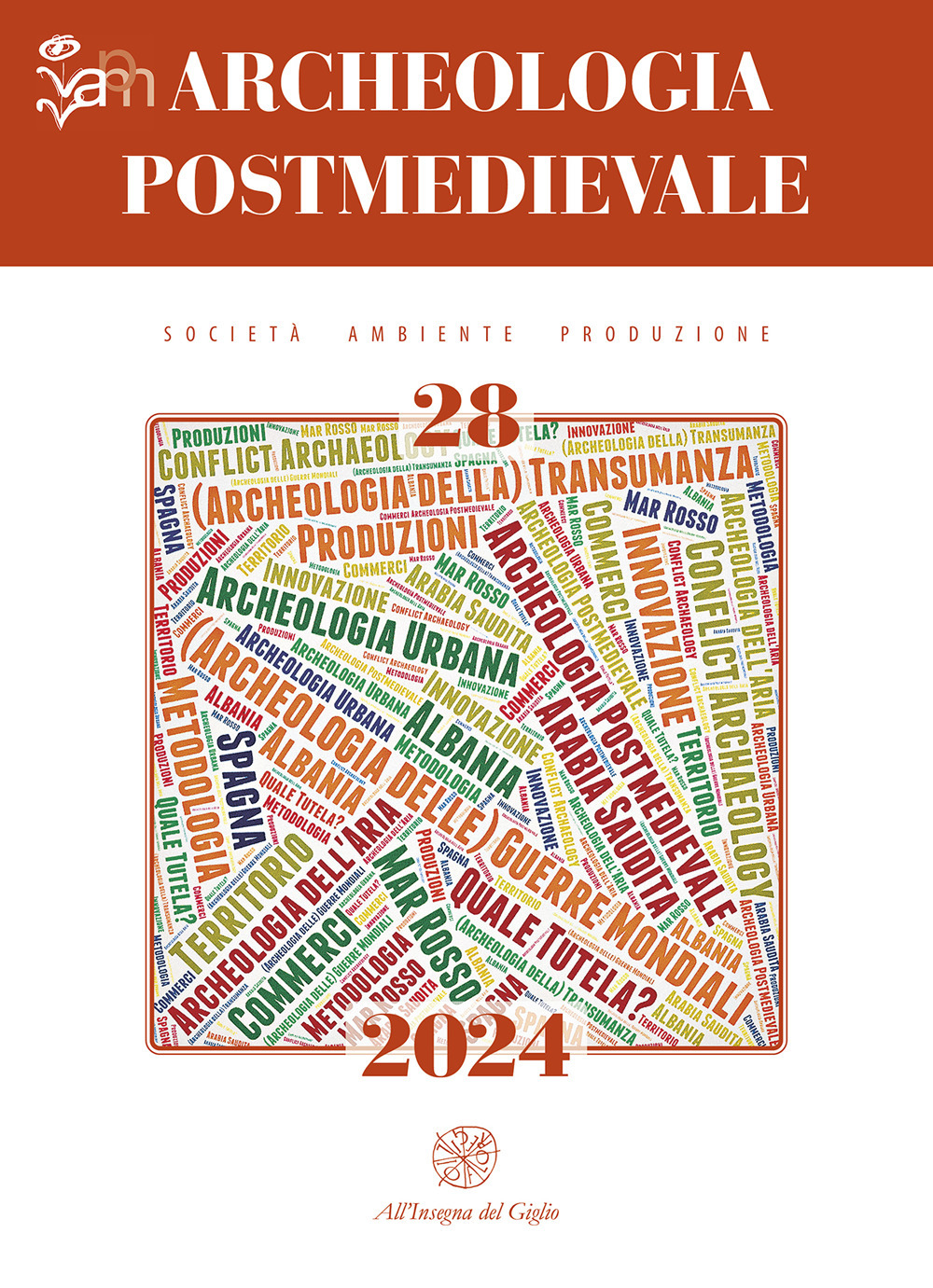Società, ambiente, produzione
Società, ambiente, produzione
In continuation of a consolidated tradition of this publication, issue number 28 (2024) presents innovative aspects, like an increase in the internationalization which is represented by the essays on important underwater and land sites in Saudi Arabia (the Red Sea), Albania (Durrës) and Spain (Roses-Catalogna) and state-of-the-art methodological themes concerning the protection of the post-Medieval archeological heritage.
This issue of APM contains innovations related to geographical areas which are dealt with here for the first time, but also for certain subjects like the archeology of post-Medieval transhumance, the archeology of the air, 14C applied to post-medieval finds, an 18th century shipwreck in Saudi Arabia which demonstrates the existence of international trade between the Indian Ocean and the West.
The numismatic evidence from the military fortress at Rosas in Catalonia proves that the coins belonging to the military personnel were the same as those used by the local economy system in which foreign soldiers (French) had been completely integrated.
One of the essays is dedicated to a collection of bronze weights and measures dated from 1613 to 1781, preserved in the Genoese area and passed down from one generation to the next which includes an interesting oral memoir.
The production of bricks at Trevi (Umbria) is analysed using a specific source which is the Register of taxes paid by the kilns during the period from 1592-1797.
The section dedicated to Conflict Archaeology covers a wide chronological range from 1503 to the First and Second World Wars with an initial essay dedicated to a cannon attributed to Louis XIII of France and extends to the archeological approach at the Altopiano dei Sette Comuni (Vicenza) for the study of the First World War sites and then to the results of the 2023 research campaign conducted in the areas of some of the Austro-Hungarian prisoner of war camps on the island of Asinara.
The article on the wrecks of aircraft from the Second World War which crashed on the Maiella (National Park, Abruzzo) in this publication (and not only this one) opens the subject of the archeology of air, in particular in relation to the Second World War.
Along with the occasional scientific initiative (which are subjected to the same ministerial authorizations as the prehistoric, classical and medieval sites) the archeological sector of the First and Second World Wars is polluted at a national level by the uncontrolled universe of treasure hunters, memorabilia seekers, and metal detector enthusiasts who subtract from the collective heritage materials which are removed from their context and end up in private collections. This is a scourge which, in order to be eliminated, requires an increased awareness of the archeological importance of this historical evidence which rarely and only formally, receives recognition as part of the national archeological heritage (and paradoxically, only when the intention to deal with it using archeological research methods are expressed explicitly!).
The Roman amphitheatre at Durrës has all of the potential for information of the monumental areas of classical antiquity in the centuries following the Roman era. The paper dedicated to the epigraphical aspects of the complex of Santa Maria di Betlem in Sassari demonstrates how the wall surfaces represent palimpsests of graffiti that are extremely informative.
The Calabrian territory of Briatico (Vibo Valentia) has been studied with a diachronic, global approach, while one of the other articles analyses the complex of post-medieval rock graffiti in the Val Brembana (Carona, Bergamo), which documents the history of transhumance from the Po River valley to the Orobie Alps.
The last paper in the review highlights the way in which 14C, even in post-medieval chronologies can represent a decisive component in the dating process.
The liveliness of the thematic and methodological approaches opens innovative new pathways for research and consolidates and broadens the areas of research (Conflict Archaeology) that are recent and less recent (Urban and Territorial Archeology) with a broad European and intercontinental perspective and with this issue establishes a new and significant stage of growth and development for post-medieval archeology in Italy.
- N° scheda: R25000003
- ISBN-13: 9788892852518
- Number Volumes: 1
- Authors: AA.VV.
- City: SESTO FIORENTINO
- Publisher: All'Insegna del Giglio
- Year: 2025
- Month: January
- Necklace title: Archeologia Postmedievale
- Necklace number: 28
- Number of pages: 294
- Illustrations: COL + B/W
- Dorso: 29 cm
- Larghezza: 21 cm
- Peso: 1220 gr
- Country: Italy
- Language: Multilingual
- Condition: New
- Type of publication: Magazine
- Dewey Classifications: Social sciences; History of ancient world to ca. 499
- Contains: Index



